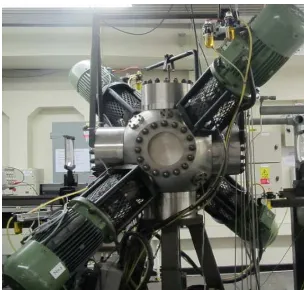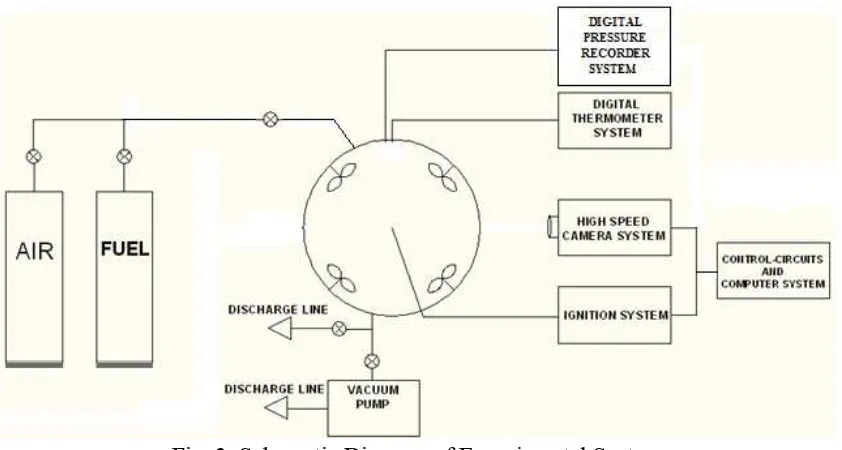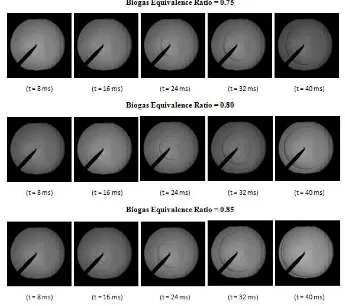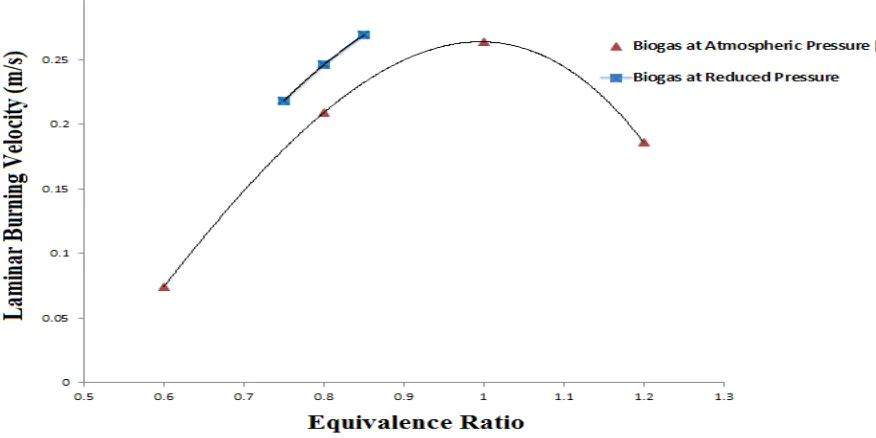!
" sustainable and renewable. Based on chemical analysis, the composition of the biogas produced in East Java is 66.4% methane, 30.6% carbon dioxide and 3% nitrogen. Methane is a flammable gas, whereas, nitrogen and carbon dioxide are inhibitors. Given it has a different composition to traditional fuels, a fundamental study of biogas flame propagation characteristics is desirable to quantify this important fuel property. Spherically expanding flames propagating at constant pressure are employed to measure the laminar burning velocity and flammability characteristics as mixture function of the mixture composition. These important parameters were measured using a photographic technique in a high pressure fan-stirred bomb. The characteristics of biogas-air flames were initially studied at reduced pressure and at various equivalence ratios from the lower flammable limit to the upper flammable limit. The results were compared with those from biogas-air flames at atmospheric pressure. Based on this experimental investigation, the laminar burning velocities of biogas-air mixtures at reduced pressure were 0.218 m/s for ϕ=0.75, 0.246 m/s for ϕ=0.80 and 0.269 m/s for ϕ=0.85 respectively and only for these biogas mixtures propagated at reduced pressure. At the same equivalence ratio (ϕ), the laminar burning velocities of the biogas-air mixtures at reduced pressure are higher than those at atmospheric pressure. The flammable region of biogas became narrower by reducing initial pressure. The dilution effect is stronger at reduced pressure. Therefore, the flammable composition mixture areas of biogas-air mixtures are more limited at reduced pressure than those at atmospheric pressure.Biogas, an alternative fuel that is both sustainable and renewable is produced from anaerobic fermentation of organic material in digestion facilities [1,2,3]. It does not contribute to the increase in atmospheric carbon dioxide concentrations because it comes from an organic source with a short carbon cycle and is a green solution in the development of sustainable fuels [1,2]. Furthermore, the digestion facilities can be constructed quickly in a few days using unskilled labor [4]. Biogas contains 50–70% methane and 30–50% carbon dioxide, as well as small amounts of other gases and
typically has a calorific value of 21–24 MJ/m3 [3,5,6]. Based on chemical analysis, the composition
of the biogas produced in East Java is 66.4% methane, 30.6% carbon dioxide and 3% nitrogen [1,2]. Methane is a flammable gas, whereas, nitrogen and carbon dioxide are inhibitors [7]. Following the Kyoto protocol, increasing efforts have made to find alternative, environmental friendly and sustainable fuels. Whereas much useful research has already been conducted into the use of biogas for cooking (stoves) and engines such as gas turbines, more needs to be done before it becomes an important replacement for fossil fuels [3,5,6,8-15].
A fundamental study of biogas flame propagation characteristics is required before it can become a major sustainable fuel. Laminar burning velocity and flammability characteristics are both important parameters of a combustible mixture. Flammability limits give the proportion of combustible gases in a mixture, between which limits this mixture is flammable. Gas mixtures consisting of combustible, oxidizing, and inert gases are only flammable under certain conditions. The lower flammable limit describes the leanest mixture that still sustains a flame, i.e. the mixture with the smallest fraction of combustible gas, while the upper flammable limit gives the richest flammable mixture.
A fundamental study of biogas shows that the trend of laminar burning velocity changes as a function of the equivalence ratio [1,2]. The laminar burning velocity of a rich biogas-air mixture is lower than that of a lean mixture [1,2]. This reinforces the observation that the effect of inhibitor gases in biogas on laminar burning velocities is higher in rich mixtures than that in lean ones due to
the higher mole fraction of these inhibitor gases. This is due to the fact that CO2 in biogas dilutes
the fuel mixtures and obstructs the reaction, and at the same time absorbs reaction heat thus further
reducing the rate of reaction. The action of CO2 resembles the effect of high pressure by increasing
the diffussion time and reducing the residence time of the reactant or by reducing the thermal diffusivity and increasing the reaction time [16,17]. A better understanding on the role of CO2 in biogas may be obtained from reducing the pressure where the thermal diffusivity of the fuel mixtures is higher. Thus it is expected that the reaction time will be shorter. However, the laminar burning velocity of biogas at reduced pressure, as a fundamental characteristic of the fuel, has not been studied yet. Thus, the aim of this paper is to investigate its laminar burning characteristics at reduced pressure.
Demands for replacing fossil fuels in order to reduce emissions require an improved fundamental understanding of the combustion processes that occur within the internal combustion engine and an important characteristic is the burning velocity which directly affects pressure development and is often expressed in terms of laminar burning velocity [1,2,18-25]. Laminar burning velocity is the most important flame propagation characteristic in spark ignited premixed combustion and as the fundamental flame propagation characteristic of biogas requires further study, this paper looks into this matter with view to a better understanding of a new alternative and renewable fuel. The results are compared with those from biogas-air flames at atmospheric pressure as well as methane-air flames at both reduced and atmospheric pressure to emphasize the contrast between the burning velocity of methane-air mixtures and biogas-air mixtures.
The laminar burning velocity of biogas premixed combustion was measured in the Mk2 high pressure fan-stirred combustion vessel at Leeds University School of Mechanical Engineering, as shown in Fig. 1. Initially, all the experiments in this paper were performed at room temperature, at reduced pressure (0.5 atm) and at various equivalence ratios (ϕ) from the lower flammable limit to the upper flammable limit.
The bomb is a spherical stainless steel vessel of 380 mm diameter, with three pairs of orthogonal windows each of 150 mm diameter and is equipped with four fans driven by electric motors [1,2,1821]. The fuel-air mixtures in the Mk2 combustion bomb were centrally ignited and flame propagation was recorded by a high speed schlieren cine-photography using a Photosonics Phantom digital camera as shown in Fig. 2, operating at a rate of 2500 frames/s with a resolution of 768 x 768. The flame radius was calculated as that of a circle encompassing the same area as that enclosed by the schlieren imaged flame [1,2,18-21] and the schematic diagram of experimental system as shown in Fig. 3.
Fig. 2. High Speed Schlieren Cine-Photography
Fig. 3. Schematic Diagram of Experimental System
The laminar burning velocity of a spherically expanding flame can be deduced from the
schlieren photographs, the stretched flame velocity (Sn) can be derived from the flame radius versus
time data as: Sn = dru/dt, where ru is the flame radius in the Schlieren photographs and t is the elapsed time from spark ignition. The flame stretch rate α is defined as α = d(ln A)/dt = (dA)/(A dt), where A is the area of the flame. In the case of a spherically propagating premixed flame, the flame
stretch rate can be calculated by α = (2/ru)(dru/dt). A linear relationship between flame speed and
the total stretch exists, and this is quantified by burned gas of Markstein length, Lb, and is defined at the radius, ru, such that: Sn–Ss = Lb α, where Ss is the unstretched flame speed, and is obtained as an intercept value of Sn at α = 0 in the plot of Sn against α. The gradient of the best straight line fit to
the experimental data gives Lb. The unstretched laminar burning velocity, ul, was deduced from Ss
Based on this experimental investigation at various equivalence ratios from the lower flammable limit to the upper flammable limit, the flames were propagated for lean (ϕ=0.75, ϕ=0.80, ϕ=0.85) biogas-air mixtures at reduced pressure and these mixtures are the only biogas–air mixtures propagated at reduced pressure. The images obtained from the spherical flame propagation within the combustion bomb are shown in Fig. 4.
Fig. 4. Biogas Flame Propagation at Various Equivalence Ratios and Reduced Pressure
The radius of the spherical flame propagation biogas-air mixtures at reduced pressure in Fig. 4 are presented in Fig. 5 as a function of elapsed time. Based on the experimental results and the calculations, as mentioned in the experimental method and in the previous studies [1,2,18-21], the laminar burning velocities of biogas-air mixtures in premixed combustion at reduced pressure are 0.218 m/s for ϕ=0.75, 0.246 m/s for ϕ=0.80 and 0.269 m/s for ϕ=0.85 respectively.
Based on the results of the experiments at reduced pressure, biogas flame propagates only in a very narrow range of equivalent ratio, from ϕ=0.75 till ϕ=0.85. For better understanding, the results from previous study on the laminar burning velocities of biogas at room temperature, atmospheric pressure and various equivalence ratios (ϕ) are also presented in Fig. 6 [1,2].
Fig. 6. Laminar Burning Velocities of Biogas at Atmospheric Pressure and Reduced Pressure
The flame for biogas–air mixtures at atmospheric pressure propagates between ϕ=0.6 and ϕ=1.2. At ϕ≥1.3, the flame does not propagate because of two reasons: the combustion reaction is quenched by the larger mass of fuel and some of the heat energy is absorbed by inhibitors that strengthen the quenching effect. At ϕ≤0.5, the flame can not propagate because the reaction heat energy is insufficient to burn the mixture. Compare to a methane-air mixture, the presence of carbon dioxide and nitrogen in the biogas caused a reduction in the laminar burning velocity [1,2,27] for two reasons. First, the dilution effect leads to a lower concentration of reactive species in the fuel-air mixtures for a given equivalence ratio, which lead in turn to a lower overall chemical reaction rate in the bimolecular reactions in the fuel oxidation reaction process. Secondly, the presence of these additional inhibitor gases absorbed some of the heat generated, thus lowering the flame temperature which in turn tends to reduce the overall rate of many of the chemical reactions within the fuel oxidation process. The effect of inhibitor gases is stronger in rich mixtures because the rich biogas-air mixtures have a higher fraction of the carbon dioxide and nitrogen components compared to lean biogas-air mixtures [1,2,27].
The laminar burning velocities at reduced pressure are higher than those at atmospheric pressure. This is due to the effects of low pressure that reduces the diffusion time and increases the residence times of the reactant or increases the thermal diffusivity and reduces the reaction time [15,16] which in turn increases the laminar burning velocity. The trend is consistent with the higher laminar burning velocity at lower pressure reported by [19]. Biogas flame at reduced pressure, the flame propagates in a very narrow range of equivalence ratio, i.e., from ϕ=0.75 to ϕ=0.85. In this case, the inhibitors in biogas dilutes more the fuel mixtures that obstructs the reaction stronger and at the same time absorbs the reaction heat energy, thus the very low reaction heat energy is only sufficient for burning fuel mixtures in a very narrow range of equivalence ratio.
The presence of carbon dioxide and nitrogen in the biogas-air mixtures cause a reduction in the laminar burning velocity for two reasons, First, the dilution effect lead to a lower concentration of reactive substances in the fuel-air mixture for a given equivalence ratio, which lead to a lower overall chemical reaction rate in the bimolecular reactions in the fuel oxidation reaction process. Secondly, the presence of inhibitor gases absorbed some of the heat generated, thus lowering the flame temperature which in turn tended to reduce the overall rate of many of the chemical reactions within the fuel oxidation process. At reduced pressure, the diffusion time of reactant decreases so that the resident time of reactant become longer. Consequently, the laminar burning velocity become higher than that at atmospheric pressure. The fuel fraction of biogas at reduced pressure is lower. Therefore, the dillution effect of inhibitors in the fuel become stronger. As a result obstraction of reaction by inhibitors is stronger. At the same time, the heat energy from the reaction is absorbed by the inhibitors. The resultant of these effects makes the flammable area of biogas at reduced pressure becomes very narrow. The effect of inhibitor gases is stronger at rich mixtures because the rich biogas-air mixtures have a higher fraction of carbon dioxide and nitrogen components compared to the lean biogas-air mixture. Futhermore, to make biogas as a sustainable and renewable fuel in transportation area, study of biogas flame propagation characteristics at high pressure and engine experiments is required.
Many Thanks to Direktorat Jendral Pendidikan Tinggi Kementrian Pendidikan Nasional Republik Indonesia, Universitas Brawijaya, Petra Christian University, Leeds University, Prof. M. Pourkashanian (Leeds University), Professor Derek Bradley (Leeds University), Professor Mike Pilling (Leeds University), Akihiro Hayakawa (Department of Mechanical Engineering Kyushu University, Japan) and Bambang Pudjianto (BBA Gas) for their support during this research.
[1] Anggono W, Wardana ING, Lawes M, Hughes KJ, Wahyudi S, Hamidi N. Laminar Burning
Characteristics of Biogas-Air Mixtures in Spark Ignited Premix Combustion. Journal of Applied Sciences Research 2012;8:4126-32.
[2] Anggono. W., Wardana. I.N.G., Lawes. M., Hughes. K.J., Wahyudi. S., Hamidi. N., and
Hayakawa. A.. Laminar Burning Velocity and Flammability Characteristics of Biogas-Air Mixtures in Spark Ignited Premix Combustion. Journal of Physics Conference Series 2013; 423:012015(1-7)
[3] Cacua K, Amell A, Cadavid F. Effects of oxygen enriched air on the operation and
performance of a diesel-biogas dual fuel engine. Biomass and Bioenergy 2012;45:159-167.
[4] Lichtman R, Ellegard A, Lal S, Sharma N. The Improved Biogas Systems Project: results and
future work. Energy for Sustainable Development 1996;3(4):28–42.
[5] Ferrer I, Garfi M, Uggetti E, Marti LF, Calderon A, Velo E. Biogas production in low-cost household digesters at the Peruvian Andes. Biomas and Bioenergy 2011; 35:1688-74.
[6] Bond T, Templeton MR. History and future of domestic biogas plants in the developing
world. Energy for Sustainable Development 2011;15(4):347–54.
[7] Ilminnafik N, Hamidi N, Wardana ING. Behavior of flame propagation in LPG premixed
combustion with carbon dioxide inhibitor. International Journal of Academic Research 2011;3(2):705-8.
[8] Flesch TK, Desjardins RL, Worth D. Fugitive methane emissions from an agricultural
biodigester. Biomas and Bioenergy 2011;35:3927-35.
[9] Lafay Y, Taupin B, Martins G, Cabot G, Renou B, Boukhalfa. Experiment study of biogas
[10] Nathan SS, Mallikarjuna JM, Ramesh A. An experimental study of the biogas–diesel HCCI mode of engine operation, Energy Conversion and Management 2010;51:1347–53.
[11] Porpatham E, Ramesh A, Nagalingam B. Investigation on the effect of concentration of methane in biogas when used as a fuel for a spark ignition engine. Fuel 2008;87:1651-9. [12] Masera O, Edwards R, Arnez CA, Berrueta V, Johnson M, Bracho LR, Riojas-Rodríguez H,
Smith, KR, Impact of Patsari improved cookstoves on indoor air quality in Michoacán, Mexico. Energy for Sustainable Development 2007;11:45-56.
[13] Venkataraman C, Sagar AD, Habib G, Lam N, Smith KR, The Indian National Initiative for Advanced Biomass Cookstoves: The benefits of clean combustion. Energy for Sustainable Development 2010;14:63-72.
[14] Alwis AD. A review of Sri Lanka's performance with a renewable energy technology. Energy for Sustainable Development 2002;6(1):30–37.
[15] Kurchania AK, Panwar NL, Pagar. S.D. Design and performance evaluation of biogas stove for community cooking application, International Journal of Sustainable Energy 2010;29:116-23.
[16] Fristrom RM, Westnberg AA, 1965. Flame Structure, McGraw-Hill.
[17] Glassman. I., Yetter R.A., 2008. Combustion. Fourth edition. Academic Press. Elsevier. [18] Gillespie L, Lawes M., Sheppard CGW, Woolley R. Aspects of laminar and turbulent burning
velocity relevant to SI engines. SAE Paper Series 2000-01-0192.
[19] Gu XJ, Haq MZ, Lawes M, Wooley R. Laminar burning velocity and Markstein lengths of methane-air mixtures. Combustion and Flame 2000;121:41-58.
[20] Bradley D, Hicks RA, Lawes M, Sheppard CGW, Wooley R. The measurement of laminar burning velocities and Markstein numbers for isooctane-air and iso-octane-n-heptane-air mixtures at elevated temperatures and pressures in an explosion bomb. Combustion and Flame 1998;115:126-44.
[21] Serrano C, Hernandez JJ, Mandilas C, Sheppard CGW, Woolley R. Laminar burning behaviour of biomass gasification-derived producer gas. Hydrogen Energy 2008;33:851–62. [22] Marshall SP, Taylor S, Stone CR, Davies TJ, Cracknell RF. Laminar burning velocity
measurements of liquid fuels at elevated pressures and temperatures with combustion residuals. Combustion and Flame 2011;158:1920–32.
[23] Miao H, Min J, Qi J, Qian H, Huang Z. Laminar burning velocity and Markstein length of nitrogen diluted natural gas/hydrogen/air mixtures at normal, reduced and elevated pressures. Hydrogen Energy 2009;34:3145–55.
[24] Liao SY, Jiang DM, Gao J, Huang ZH, Cheng Q. Measurements of Markstein numbers and laminar burning velocities for liquefied petroleum gas–air mixtures. Fuel 2004;83:1281–8. [25] Metghalchi M, Keck JC, Laminar burning velocity of propane-air mixtures at high
temperature and pressure. Combustion and Flame 1980;38:143-54.
[26] Aung KT, Tseng LK, Ismail MA, Faeth GM. Response to comment by S.C. Taylor and D.B. Smith on “Laminar burning velocities and Markstein Number of Hydrocarbon/air flames. Combustion and Flame 1995;102:526-530.



